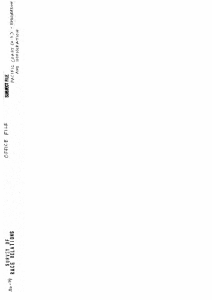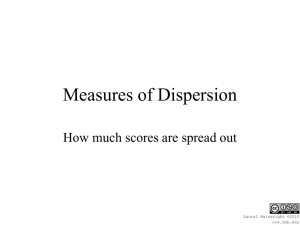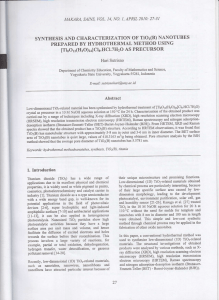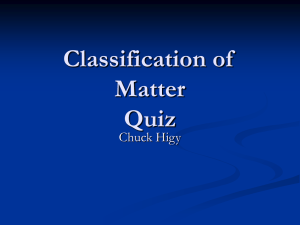PDF hosted at the Radboud Repository of the Radboud University
advertisement
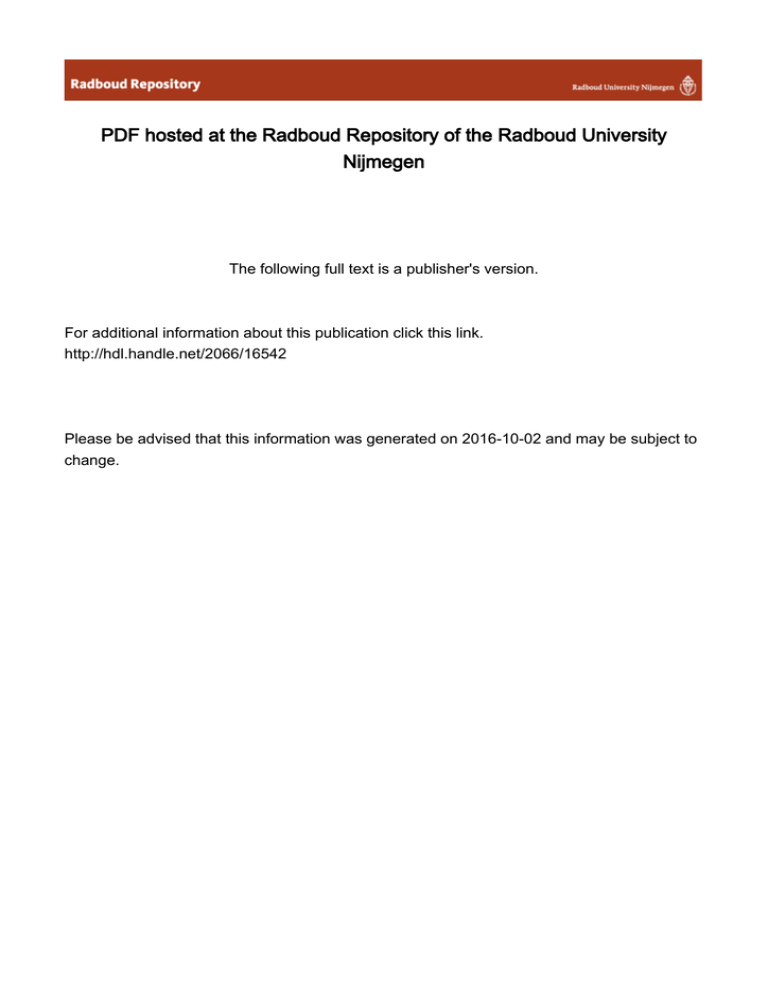
PDF hosted at the Radboud Repository of the Radboud University Nijmegen The following full text is a publisher's version. For additional information about this publication click this link. http://hdl.handle.net/2066/16542 Please be advised that this information was generated on 2016-10-02 and may be subject to change. COMMUNICATIONS OMe w as quenched w ith an excess o f m ethyl iodide w ith in 30 min at 0 °C . Subsequent cy clization to the hem iketal in acid ic m edium gave soraphen A la ( l a ) in 70% yield. R eceived; Ju ly 20, 1994 [Z 7149] G erm an version: Angew, Chem . 1 9 9 4 ,106, 2521 OMe 15 OMa 16 Schem e 4. u) /B u L i, T H F , 90 m in , - 7 8 °C : B zC l, p y rid in e, 1 2 h , 2 0 “C ; 5 % N a /H g , 5 h , - 20 "C, 3 5 % ; b) B u4N F , T H F , I h , 0 ° C , 8 5 % ; c) nB yL i, C l C 0 2E t, T H F , 1 h, - 3 0 “C, 8 5 % ; d) m o rp h o lin e, T H F , 2 h , reflu x ; 6 0 % C H 3C 0 2H , 2 h , 50 C , 7 5 % ; e) TBD PSC 1, im id azo le, D M F , 7 d , — 60 “C , 9 6 % ; f) A c20 , p y rid in e , 4-d im elh y lam in o p y rid in e, 30 m in, 0 'C , 9 8 % ; g) H C (O M e )a , C H ,C 1 2 , M e O H , 4 d , 2 0 ° C , 9 9 % ; h) T i( 0 /P r ) 4 , 2 -(trim eth y lsiIy l)eth an o I, 3 d , 1 0 0 “C, 9 0 % ; i) C sF, D M F , I d , 2 0 "C, 9 8 % ; j) thexyldim ethylsilyl c h lo rid e (T D M S C I), C H 2C12, trieth y h im in e , 20 m in, 2 0 " C ; ( C H j) 2C = C B r ( N M e 2), C H X 1 ,, trie th y la m m e , 1 h, 2 0 “C , 91 % ; k) triethylam ine, a c e to n e , H 20 , 15 ra in , R T ; C s 2C 0 3, D M F , 1 d , 20 “C, 5 0 % ; I) te lrab u tyliim m onium fluoride, T H F , 4 h , 0 “C , 1 M HC1, T H F , I d , 2 0 "C , 9 5 % ; m) 2 e q u iv o r p o ta ss iu m -2 ,6 -d i-rm -b u ty lp h e n o x id e , D M F , I d , 2 0 °C ; M e l, D M F , m olecular sieves (4 A ), 30 m in, 0 “C ; HC1, T H F , 1 2 li, 20°C , 7 0 % , m ate after d e sily la tio n .1131 S u b se q u e n t a d d ition o f w ater across the triple b o n d via an e n a m in e in term ed ia te fo llo w e d by c le a v ­ age o f the p rotectin g g r o u p s resu lted in the tetrah yd rop yran ring structure o f 15. E xp e r im e n ts by G . H o fle et al. o n the ringopened so ra p h en d em o n stra te d th at th e la cto n iz a tio n is best effected by a su b stitu tio n rea ctio n o f the cesiu m sa lt o f the carb oxylic a c id .'141 T h erefo re, b en zyl a lco h o l 15 and th e b r o m o enam ine rep orted by G h o se z e t a l . I15] were a llo w ed to react under m ild c o n d itio n s an d y ie ld e d b rom id e 16 w ith c o m p lete inversion. T h e m a c ro c y cliza tio n o f the cesiu m ca rb o x y la te o f 16 (20 °C, 60 % yield ) p ro d u ce d th e so r a p h en ring structure also with in version at the b en zyl g ro u p . S in ce the m eth yl g r o u p in soraphen A Ja (1 a), that is in a -p o s itio n to the la cto n e occu p ies the th erm od yn am ically fa v o r e d c o n fig u r a tio n ,1163 it w as in tr o ­ duced in the last step o f th e sy n th e sis. By u sin g tw o e q u iv a len ts o f p otassiu m 2 ,6 -d iim -b u ty I p h e n o x id e , the h e m ik e ta l rin g o f norsoraph en I b w as o p e n e d a n d d e p r o to n a te d to give the potassium e n o la te. To a v o id o v e rm e th y la tio n , the e n o la te ion 2468 © V C H Verlagsgeselhichafi m b H , D -69451 W einheim , 1994 [1] H . R eichenbach, G . H öfle, H . A ug u stin iak , N . B edorf, E. F o rch e, K . G erth, H . Irschik, R. Jau sen , B. K u rze, F. Sasse, H. Steinm etz, W. Trow itzsch-K ienast, E P 282455; [Chem. A b str. 1989, 111, 132597]. [2] N . B edorf, D . S ch o m b u rg , K . G erth , H . R eichenbach, G . Iiö fle , Liebigs Ann. Chem . 1993, 1017. [3] J. R ohr, N achr. Chem , Tech. L ab. 1993, 41, 889. [4] M . B öhringer, H .-J. R o th , J. H unziger, M . G ö b el, R. K rish n a n , A . G iger, B. Schw eizer, J. S ch reib er, C, L e u m an n , A. Eschenm oser, lie lv . C hun. A c ta 1992, 75, 1417; R. J. F e rrie r, N . P rasad , J. Chem. Sue. C. 1969, 570. [5] E. J. C orey, D . Seebach, A n g e it'. Chem. 1965, 77, 1134; Angew . C hem . Int. Ed. Engl. 1965, 4, 1075. T h e su b stitu tio n reaction on p h en y lo x iran c resulted in a regioselectivity o f 8:1 ( —35 °C) in fav o r o f the desired isom er. [6] S. H an essian , J.-R . P o u g n y , I. K . B oessenkool, Tetrahedron 1984, 40, 1289. [7] M . T. R eetz, A ngew . Chem. 1984, 96, 542; Angew . Chem. Int. E d Engl. 1984, 23 ,5 5 6 . W h e n using the m agnesium salt o f acetylcnc on ly the d esire d i>-g/veero isom er 11 was d etected . T h e fo rm a tio n o f the L-glycero isom er, how ever, was favored in a ra tio o f 8:1 w hen using the triiso p ro p y lo x y titan iu m salt. [8] F u rth e r d etails o f th e crystal stru ctu re investigation are av ailab le on request fro m the D irecto r o f the C am b rid g e C ry stallo g rap h ic D a ta C en tre, 12 U nion R o ad , G B -C am b rid g e C B 2 1EZ (U K ), on q u o tin g the full jo u r n a l citatio n . [9] M . Julia, J.-M . P aris, Tetrahedron L ett. 1973, 14, 4833. [10] G . P ro cter, D . G en in , Carbohydr. R es. 1990, 202, 81. [11] I. N ak ag aw a, T. H a ta , Tetrahedron L e tt. 1975, 16, 1409. [12] F o r the stereo ch em istry o f the Ju lia reactio n see P. J, K ocienski, B. L ythgoe, S. R u sto n , J. Chem. Soc. P erkin Tram . 1 1978, 829, [13] G . Solladie, C. H a m d o u c h i, Synthesis 1991, 979. [14] D . S chum m er, B. B öh len d o rf, M . Kiffe, G. H ö lle in A n tib io tics and Antiviral Com pounds (E d s.: TC. K ro h n , H . A. K rist, H . M aag ), V CH , W einheim , 1993, p. 133. [15] F. M u n y em an a, A .-M . F risq u e-H esb ain , A. D evos, L. G h o sez, Tetrahedron L e tt. 1989, 39, 3077. [16] U p o n treatm en t o f so rap h en A la ( l a ) [2] w ith base (th e rm o d y n am ic condi­ tio n s), no change o f c o n fig u ratio n occurs at the m ethylated c a rb o n a to the lactone. T he cry stal stru ctu re o f l a shows th a t the m eth o x y g ro u p o f the te trah y d ro p y ran rin g an d the m ethyl g ro u p a to the lacto n e a re in a stcrically favorable p o sition relative to each oth er. In the c o rresp o n d in g epi form , how ­ ever, these m ethyl a n d m eth o x y g roups are su b ject to 1,3-diaxial interactions. T his m ight also be the reaso n w hy a possible d im eth y latio n o f n o rso rap h en 1 b can be avoided u n d e r a p p ro p ria te reaction conditions. Novel Bimetallic Model System for Cytochrome P450: Effect of Membrane Environment on the Catalytic Oxidation** A lbertus P. H. J. Schenning, D om inicus H. W. H ubert, Jan H. van Esch, M artinus C. Feiters, and Roeland J. M . N olte* C ytochrom e P450 catalyzes a variety o f ox id a tio n reactions, inclu ding the hyd roxylation o f alkanes and the ep o x id a tio n o f alkenes.111 The active site o f this m em brane-bound enzym e con ­ tains a hem e fu n ction and a thiolate as axial ligand. T h e catalyt­ ic cycle involves the binding o f a substrate, reduction o f iron(m) to iron (n), and bin ding and reductive cleavage o f m olecular oxygen to generate w hat is form ally an o x o iro n (v ) com plex, [*] P rof. D r. R . J. M . N o lte, D ip l.-C h em . A. P. II. J. Schenning, D . H . W. H ubert, D r. J. H. van E sch, D r. M . C. F eiters D ep artm en t o f O rg an ic C hem istry, N S R C en ter, U niversity o f N ijm egen T oernooiveld, N L -6525 E D N ijm egen (The N eth erlan d s) Telefax: In t. code + (80)55-34-50 [**] T his w ork was s u p p o rte d by the N eth erlan d s F o u n d a tio n fo r C hem ical R e­ search (SO N ) w ith financial aid from the N eth erlan d s O rg an iza tio n lo r Scien­ tific R esearch (N W O ). 0570-11X3319412323-2468$ 1 0 .0 0 + .2 5 /0 Angew. Chem. In t. Ed. Engl. 1994 ,33, No. 23124 COMMUNICATIONS which transfers its oxygen atom to the bou nd substrate. The iron cen ter accepts the electrons from N A D P H , through m edia­ tion o f a flavop rotein . B ecause o f its b iological im portance— this enzym e plays a crucial role in the m etab olism o f end ogen eou s chem icals and x en ob iotic c o m p o u n d s - and also because this archetype oxida­ tion catalyst m ay serve as a m odel for a new generation o f synthetic catalysts, a great deal o f research is currently focused on m im ick in g the action o f cytochrom e P450.[2] U n til n o w only a few m o d els have been described that incorporate the im por­ tant featu res o f the natural system , nam ely m olecular oxygen as the o x id a n t, a m etalloporph yrin as catalyst, an electron don or, and a m em b ran e system h old in g these com p on en ts.131 A ll m od ­ els have the disadvantage o f displaying very low catalytic activity. D u rin g the course o f our studies on novel supram olecular catalytic system s, w e fou n d that the rhodium com plex [R hnl(ij5C p *)(b p y)C l2] (Cp* = pentam ethylcyclopentad ienyl, bpy = 2,2'-bipyridine) is an efficient catalyst for the reduction o f m anganese(m ) porphyrins by sodium form ate.141 We report here on a m em b ran e-b ou n d cytoch rom e P450 m im ic that epoxidizes alkenes w ith g o o d turnover num bers. T h e system is com p osed o f vesicles con tain in g an a-(aceto)-[5,10,15,20-tetrakis(2,6-dichlorop henyl)-porph yrinato]m angan ese(m ) catalyst ([M nmt2 6 diClPP] 1 ),[51 jV -m ethylim idazole as axial ligand, and an am phiphilic rhodiu m (m ) com p lex (2 ) [6! in com b in ation w ith sodi­ um form ate as electron don or. We found that the type o f m em ­ brane has a dram atic effect on the catalytic activity o f the m im ic. T he m an gan ese porphyrin I and the rhodium com plex 2 were incorp orated into p ositively charged dim ethyl-dioctadecylam m onium chloride (D O D A C )[?1 and negatively charged dih exad ecylp h osp h ate (D H P ) [?1 vesicles by the ethanol injection m eth od .[lil G el perm eation chrom atograph y and electron m i­ croscop y w ere used to sh o w that the porphyrin and the rhodium com plex were bou nd to the bilayers o f the vesicles and that the vesicle structure w as not destroyed by the incorporation proce­ dure. T h e diam eters o f the vesicles o f b oth am phiphiles am oun t­ ed to a b o u t 4000 A. T he fluorescence spectra o f H 2-t2 6-diClPP in b oth D O D A C and D H P vesicles ( T = 7 0 °C) show ed n o ef­ fects o f self-q u en ch in g w hen the porphyrin to lipid ratio w as low er than 0.005. T his indicates that below these ratios the porphyrin m olecu les are n ot aggregated.191 The addition o f w a ­ ter-soluble quenchers (N a l and C u S 0 4 in the case o f D O D A C and D H P vesicles, respectively) to the system did not change the fluorescence spectrum o f the vesicle-bound H 2-t2i6-diC lPP. M ost lik ely the porphyrin is situated in the inner part o f the vesicle bilayer. E P R studies, using [Cun(t2i6-diClPP)] instead o f 1 revealed th at for b oth vesicle system s the orientation o f the porphyrin m olecu les w as parallel to the vesicle surface.1101 T he structure o f the m odel system is depicted in Figure 1. First w e investigated the influence o f the m em brane m atrix on the red uction o f the m anganese(in) porphyrin. To this end the Angew. C/icm . Ini. Ed. Engl. 1994 ,33, No. 23/24 © vesicle bilayer f V / W \A /W N A A A /V V V V X \^ v V \A A A /A /V V y — ^ V V W V V V X A A A A /W V V W co m p lex 2 p o rp h y rin 1 A r w w w v V W H C 02- \ W W V \ /V W V V W /■ [Rhl"(Cp*)(bpy)]2+ C02 A'V^ [HRh1"(Cp*)(bpy)]+ / \ W A o Mn‘"(P) > ^ ) A ( + Hî° Fig. 1. S ch em atic re p re s e n ta tio n o f th e c y to c h ro m e P4S0 m im ic an d th e catalyzed reac tio n , d ecrease in the a b so rp tio n at 660 nm (M n UI porph yrin ) and the in crease in ab so rp tio n at 448 nm (M n" p orp h yrin ) in th e U V / V IS sp ectru m w a s fo llo w e d as a fu n ctio n o f tim e, b oth under an argon atm osp h ere and in air. T h e rh o d iu m com p lex m a n g a n o p orp h yrin ra tio w as varied from 0.5 to 10. U n d e r argon in D O D A C as w ell as in D H P vesicles, th e M n"1 porph yrin w as red uced at all R h /M n ratios tested . T h e red u ction rate w as fo u n d to increase lin early w ith th e R h 111 c o n cen tra tio n . A t a fixed R h /M n ratio the red u ction w as faster in D O D A C vesicles th an in D H P vesicles ([R h ]/[M n] = 1; k 0 (D O D A C ) > 100 n m o lL s , k a (D H P ) = 20 + 2 n m o lL ' ' 1 s ~ ‘). T h e red u ctio n o f M n 111 in D O D A C v esicles a lso to o k p lace w hen the r eaction s w ere carried o u t in an air a tm o sp h ere. A sim ilar result w as ob ta in ed fo r D H P ex cep t w h en the R h /M n ratio w as equal or less than 1, under w h ich c o n d itio n s reo x id a tio n o f M n 11 w as ob served . In th e ab sen ce o f the R h in c o m p le x or form ate no red u ctio n to o k place. T h e se results in d ic a te th a t the rhodiu m form ate system is ca p a b le o f red u cin g the m em b ran e-b ou n d M n 111 p orp h yrin and p resu m ab ly, as o b serv ed p r e v io u sly ,141 the rh od iu m c o m p lex acts as a r ed ox-active p h ase transfer catalyst in th is process. T h e red u ctio n o f M n 111 is faster in the p ositively charged vesicles than in th e n egatively ch arged on es becau se the fo rm a te c o n c en tra tio n is high er at the b ilayer/w ater interface o f the form er aggregates. T h e fact th a t in D O D A C vesicles in gen ­ eral an d in D H P vesicles w ith a R h /M n ratio high er th an 1 no r eo x id a tio n o f M n 11 takes p lace, in d ic a tes th at th e red uction o f m a n g a n ese is m u ch faster than its reo x id a tio n . In a seco n d series o f exp erim en ts w e in v estig a ted w h eth er our m e m b ra n e-b o u n d cy to ch ro m e P 450 m im ic w as able to ep oxid ize alk en es. T he results are listed in T able 1. A ll su bstrates tested w ere ep o x id ized by th e catalytic system based o n D H P vesicles. T h e turnover nu m b ers are high er th an th o se ob tain ed w ith the tw o -p h a se system p r e v io u sly p u b lish ed by us.[41 T hey are in the sa m e range as th ose ob served for the natu ral system (1 nm ol p r o d u ct per n m o l P450 p er m in ).111 R em ark ab le is the high sta­ b ility o f the ca ta ly st d u rin g the reaction , w h ich is in contrast w ith the tw o -p h a se system . T h e e ffect o f the m em b ran e en viron ­ m e n t on the c atalytic e p o x id a tio n b e c a m e clear w hen the D H P vesicles w ere replaced by the D O D A C vesicles. In the latter m em b ran e sy stem no e p o x id a tio n o f alk en es w a s observed (last tw o entries o f T able 1 ). P resu m ab ly, th e c o n c en tra tio n o f p ro­ to n s is to o lo w to allo w th e form ation o f the cata ly tica lly active o x o m a n g a n e s e (v )u l) sp ecies at the p o s itiv e ly charged interface. W h en th e R h /M n ratio w as increased fro m 1 to 10 the turnover num ber o f the reaction decreased considerably (Table 1, entry 5). T h is p h en o m en o n is p o ssib ly caused b y the fact that m ore elec- VC H Vertagsge.iellschafl m b ll, D -69451 W cm heim , 1994 0570-D S33/9412323-2469 $ 10.0U + .25/0 2469 COMMUNICATIONS Table 3. E poxidation o f alkenes by the m em brane-bound cy to ch ro m e P450 m im ic [a]E ntry S urfactant S ubstrate P roduct [b] T u rn o v e r n u m b e r [c] 1 2 3 4 5 6 7 DHP DHP DHP DHP D H P [e] DOD A C D O D A C [e] a-pinene iy.y-stilbene lim onene styrene styrene styrene styrene a-pinene oxide «■«-stilbene oxide lim onene oxide styrene oxide [d] styrene oxide - 360 45 50 55 5 0 0 1,4-Didehydrobutadiene: The Intermediate in a New Class of Thermally Induced Intramolecular Alkyne Couplings** R olf G leiter* and Joachim R itter - D e d ic a te d to P ro fe sso r H ein z D im on the occasion o f his 60th birthday [a] F o r reaction conditions see E xperim ental P rocedure. T he reaction w as follo w ed by G L C for 1 h. N o destruction o f the catalyst was found after th a t p erio d , [b] T he only p ro d u c t o f the reaction was epoxide, which was gradually d ec o m p o sed in to o th e r products. The decom position processes were independent o f th e R h /M n ratio . N o epoxide was form ed w ithout vesicles o r when any o f the c o m p o n e n ts o f the catalytic system were om itted, [c] T urnover n um ber [epoxide]/l p e r h o u r, ca lcu la ted from the initial p a rt o f the convcrsion/tim e plot. a-Pinene oxide w as co n v e rted ( > 9 0 % ) in to pinocam phone w ithin a period o f one hour. L im onene o x id e d e c o m ­ posed ( ± 5 0 % ) into as yet unidentified products, [d] Styrene o xide a n d stilb en e oxide w ere stable under the experim ental conditions, [e] R h /M n m o la r ra tio = 1 0 . Irons becom e available due to the higher concentration o f rh od i­ um centers. As a result a side reaction can take place w hich produces water (the so-called non-productive p ath w ayt u I ). In summary, we have developed a bimetallic m em brane-bound cytochrom e P450 mimic which catalyzes the epoxidation o f alke­ nes with good turnover numbers. Current work is aim ed at devel­ oping catalytic systems that display substrate selectivity. M ore than tw en ty years ago Bergman and co-w ork ers d isco v ­ ered that enediynes su ch as (Z )-hexadiyn-3-ene (1) cyclize to give the corresp on d in g 1,4-didehydrobenzenes (2) as short-lived interm ediates.111 This reaction occurs at 200 °C w ith an activa­ tion energy o f 28 k c a lm o l-1 (Schem e l ) . 12"1 The recent discov- Schem e 1. C y clo aro m atiza tio n o f enediynes. Experim ental Procedure R eduction experim ents: T he desired am o u n ts o f stock solutions o f 1, 2, Nm ethylim idazole, and D H P o r D O D A C in chloroform were m ixed in a test tu b e . T h e solvent was evaporated u n d er a strea m of nitrogen to leave a h o m o g e n e o u s film. T his film was solubilized in 100jj.L e th an o l/tetra h y d ro fu ran (1 :1 , v/v ) an d injected in 1 .2 5 m L w ater a t 75°C . T h e suspension was purged w ith a rg o n for 30 m in and injected in a cuvette containing 1.25 m L o f an e th y lm o rp h o lin e/so d iu rn fo rm ate buffer at 75 X . Final conditions; 2.4 |iM o f 1, 2.4 x n jjm o f 2 (// = R h /M n m olar ra tio ), 3.95 j.im o f /V-methylimidazole, 910 hm D O D A C or D H P in eth y lm o rpholine (50 mM)/sodium form ate (250 mM) buffer (pH = 7 .0 ), T = 7 0 °C . E p oxidation experim ents: F inal conditions as above, except R h /M n m o la r ra tio = 1 and [substrate] = 200 j-tM. N ow the 100 |.iL solution was directly injected in a 2.5 m L buffered solution at 75 °C. S ubstrate w as added and the reaction m ix tu re w as a n a ­ lyzed from tim e to time by taking a 0.2 m L aliquot to which w as a d d e d O.J mL diethyl eth er containing mesitylenc as an internal standard. This m ix tu re w as sh ak en vigorously (vortex ap p a ra tu s) and centrifuged. A fter phase s e p a ra tio n , a 5 j.iL sam ple was taken from the diethyl eth er layer and analyzed by G L C (co lu m n C h ro m p ack , W C O T/C P-SIL5C B , tem perature p rogram 7 0 "C (2 m in ), 10 K m in “ 1 200 “C (2 m in)). Received: M ay 2, 1994 [Z 6891 IE] G erm an version: Angew. Clwm . 1994, 106, 2587 [1] F. P. G uengerich, J. Biol. Clwm. 1991, 266, 10019. [2] J. P. C ollm an, X . Z hang, V, J. Lee, E, S. U ffelm an, J. I. B raum an, S cien ce 1993, 261, 1404. [3] a) J, H . van Esch, M. F. Roks, R. J. M . N olte, A m . Chcm . Soc. 1986, 108, 6093; b) J. T. G roves, R . N eum ann, ibid. 1989, I I I , 2900; c) J. T. G ro v e s , S. B. U ngashe, ibid. 1990, 112, 7796. [4] P. A . G osling, J. H. van Esch, M. A . M , H offm ann, R. J. M . N o lte , J. C hem . Soc. Chem. Conmmn. 1993, 472. [5] A . D . A dler, F. L. L ongo, F. K am pas, J. K im ,./ Inorg. Nucl. C hem . 1970, 32, 2443. [6] a) U , K ölle, M , G rätzel, Angew, C hem . 1987, 99, 572; stjigeii'. C hem . In t. Ed. Engl. 1987, 26, 567; b) J. H . van Esch, M . C. Feiters, R . J. M . N o lte , J. O rg . Chem., in press. [7] A . M . C arm ona-R ibeiro, Chem. Soc. Rev. 1992, 209. [8] L. A. M , R upert, D . H oekstra, J. B. F. N . Engberts, J. A m . Chem . Soc. 1985, 107, 2628. [9] A . P. H . J. Schenning, D. H . W. H u b ert, M . C, F eiters, R. J, M . N o lte , u n p u b ­ lished results. [10] J. H . van Esch, M . C. Feiters, A .M . Peters, R .J . M . N olte, J. P hys. Chem . 1994, Wi, 5541. [11] I, T abushi, M. K odera, J. Am . Chem. Soc. 1986, 108, 1101. 2470 (ç) VCH VerlagsgeseUschaft m b ll. D-69451 W em heim , 1994 ery o f the natural an titu m or antibiotics calicheam icin, esperam icin, and dyn em icin , w hich contain the cyclic en ed iyn e unit 3, led to an en orm ou s increase in publications on en ediyne ch em ­ istry in the last seven years.131 A com m on feature in the m ech a­ nism o f action o f these antibiotics is the cy cloarom atization o f the enediyne unit 3 to give the bicyclic 1,4-didehydrobenzene 4. In the case o f n eocarzin ostatin, the electrocyclization o f an initially generated cyclic (Z )-cum ulene-enyne 7 is p ro p o sed as the key step .141 In related work M yers et al. found that the sur­ prisingly facile cyclization o f the open-chain cum ulene 5 gives a,3-d eh yd rotolu en e 6 and is an exam ple o f a new type o f a 1,4-biradical generating reaction (Schem e 2 ).[5il1 C* ^ ex.—a < 2- 100°C 2 [HI Schem e 2. C y clo aro m atiza tio n o f cum ulene-enynes. [*] P rof. D r. R . G leiter, D ip l.-C h em . J. R itter O rganisch-chem isches In stitu t d er U niversität Im N eu en h eim er F eld 270, D -69120 H eidelberg (F R G ) T elefax; In t. co d e + (6221)56-4205 [**] T his w ork was su p p o rte d by the D eutsche F orsch u n g sg em ein sch aft, the Fonds der Chem ischen In d u strie , an d the BA SF A ktiengesellschaft (L udw igshafen). J. R . th a n k s the S tu d ie n stiftu n g des deutschen Volkes fo r a d o cto ral fellowship. 0570-083319412323-2470 S 10.00 + .25/0 Angew. Chem. Ini. Ed. Engl. 1994, 33. No. 23/24

